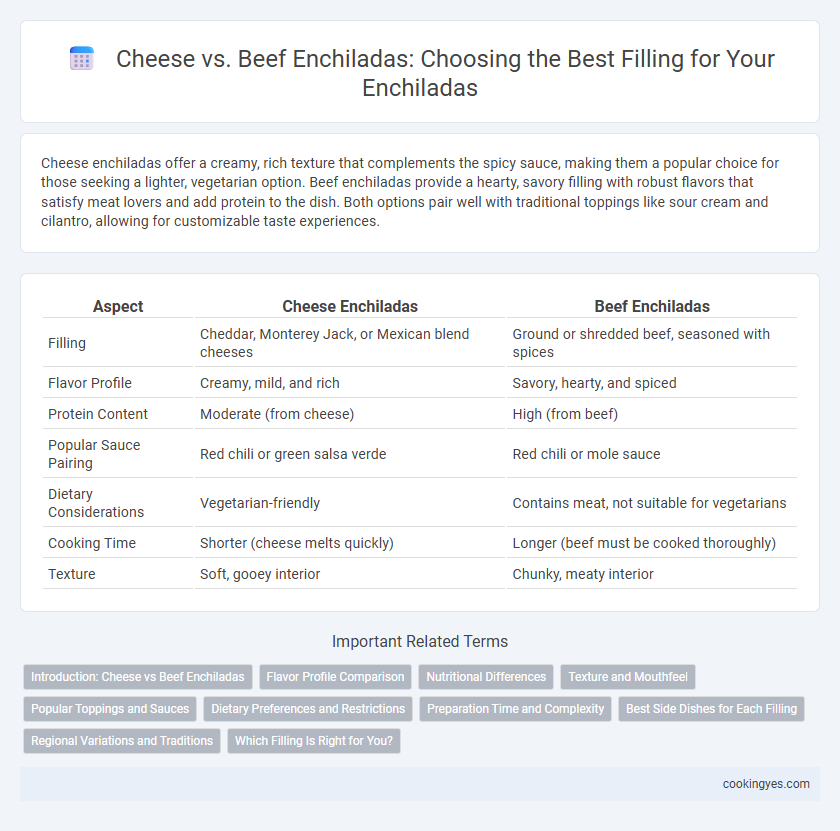Cheese enchiladas offer a creamy, rich texture that complements the spicy sauce, making them a popular choice for those seeking a lighter, vegetarian option. Beef enchiladas provide a hearty, savory filling with robust flavors that satisfy meat lovers and add protein to the dish. Both options pair well with traditional toppings like sour cream and cilantro, allowing for customizable taste experiences.
Table of Comparison
| Aspect | Cheese Enchiladas | Beef Enchiladas |
|---|---|---|
| Filling | Cheddar, Monterey Jack, or Mexican blend cheeses | Ground or shredded beef, seasoned with spices |
| Flavor Profile | Creamy, mild, and rich | Savory, hearty, and spiced |
| Protein Content | Moderate (from cheese) | High (from beef) |
| Popular Sauce Pairing | Red chili or green salsa verde | Red chili or mole sauce |
| Dietary Considerations | Vegetarian-friendly | Contains meat, not suitable for vegetarians |
| Cooking Time | Shorter (cheese melts quickly) | Longer (beef must be cooked thoroughly) |
| Texture | Soft, gooey interior | Chunky, meaty interior |
Introduction: Cheese vs Beef Enchiladas
Cheese enchiladas offer a creamy, rich filling made primarily from melted cheeses like cheddar, Monterey Jack, or queso fresco, appealing to those who enjoy a smooth and indulgent texture. Beef enchiladas provide a heartier option, featuring seasoned ground or shredded beef that adds a robust, savory flavor with spices such as cumin and chili powder. Both varieties are traditionally wrapped in corn tortillas and topped with enchilada sauce, but cheese enchiladas tend to be milder, whereas beef enchiladas deliver a more intense, protein-rich meal.
Flavor Profile Comparison
Cheese enchiladas feature a rich, creamy texture with a mild, tangy flavor from melted cheeses like cheddar or Monterey Jack, balanced by the savory enchilada sauce. Beef enchiladas offer a robust, hearty taste with ground or shredded beef seasoned with chili powder, cumin, and garlic, creating a spicier and more complex profile. The choice depends on a preference for smooth, cheesy indulgence versus bold, savory meat flavors.
Nutritional Differences
Cheese enchiladas typically contain higher levels of saturated fat and calories due to the dairy content, while beef enchiladas provide a richer source of protein and essential amino acids. Beef enchiladas also offer more iron and zinc, contributing to muscle repair and immune function, whereas cheese enchiladas deliver calcium important for bone health. Both options vary in sodium content depending on preparation, but beef enchiladas generally have a higher sodium concentration due to seasoned meat.
Texture and Mouthfeel
Cheese enchiladas offer a creamy, smooth texture that melts evenly in the mouth, providing a rich and indulgent mouthfeel. Beef enchiladas deliver a heartier, more fibrous bite with a satisfying chew that contrasts the tender tortilla and sauce. The textural difference between the soft, gooey cheese and the robust, slightly coarse beef filling significantly influences the overall sensory experience.
Popular Toppings and Sauces
Cheese enchiladas pair excellently with tangy red chili sauce and are often topped with sour cream, diced onions, and fresh cilantro to balance the rich, creamy filling. Beef enchiladas typically feature a robust, spiced tomato-based sauce or green chili sauce, complemented by shredded lettuce, diced tomatoes, and sliced jalapenos to enhance the hearty meat flavor. Popular toppings like shredded cheddar or Monterey Jack cheese melt perfectly on both varieties, adding an extra layer of savory richness.
Dietary Preferences and Restrictions
Cheese enchiladas offer a vegetarian-friendly option rich in calcium and protein, suitable for those avoiding meat or seeking lower fat content. Beef enchiladas provide a higher iron and vitamin B12 intake, catering to diets requiring more heme iron and complete proteins. Individuals with lactose intolerance or dairy allergies should avoid cheese fillings, while those managing cholesterol may prefer cheese alternatives over beef.
Preparation Time and Complexity
Cheese enchiladas typically require less preparation time and are simpler to make, involving just cheese and sauce before baking. Beef enchiladas demand more steps, including cooking and seasoning the ground beef, which increases both preparation time and complexity. Choosing cheese enchiladas offers a quicker and easier option, while beef enchiladas provide a richer flavor with a more involved cooking process.
Best Side Dishes for Each Filling
Cheese enchiladas pair exceptionally well with fresh guacamole and a crisp side salad featuring lime vinaigrette, enhancing the rich, creamy texture of the cheese filling. Beef enchiladas are best complemented by Mexican rice and refried beans, providing hearty, savory sides that balance the robust flavors of the seasoned ground beef. Both fillings benefit from a side of pickled jalapenos or sliced radishes to add a refreshing, tangy contrast.
Regional Variations and Traditions
Cheese enchiladas dominate in Northern Mexico, where mild sauces paired with creamy cheese fillings emphasize simplicity and dairy-rich flavors. Beef enchiladas are more prevalent in Southern Mexico, featuring spicier, complex sauces and shredded or ground beef that reflect the region's robust culinary traditions. These regional preferences highlight how local ingredients and cultural practices shape enchilada fillings, with Northern areas favoring cheese-filled versions and Southern regions embracing hearty beef varieties.
Which Filling Is Right for You?
Cheese enchiladas boast a creamy, mild flavor perfect for vegetarians or those seeking a lighter option rich in calcium and protein. Beef enchiladas provide a hearty, savory filling with a robust taste, high in iron and zinc, ideal for meat lovers. Choosing between cheese and beef enchiladas depends on dietary preferences, protein source needs, and desired flavor intensity.
Cheese enchiladas vs beef enchiladas for filling choice Infographic

 cookingyes.com
cookingyes.com